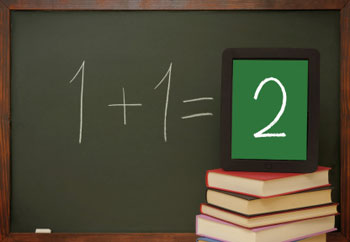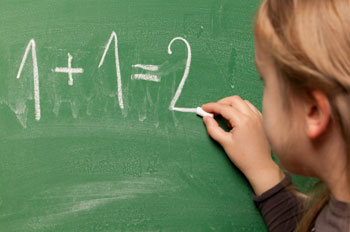3rd Grade Math Lessons: Understanding Shapes
During your child's 3rd grade geometry unit, he or she will learn about several math shapes that need to be remembered in later grades. To practice at home, try out these exercises.

Which Shapes Should My 3rd Grader Know?
Make sure your child is prepared for future math classes by practicing shape classifications at home. Ultimately, your 3rd grader should be able to classify shapes into categories, such as quadrilaterals, rhombuses and rectangles. The properties defining certain shapes may also be addressed at this level. For example, all squares are rectangles, but not all rectangles are squares. Both squares and rectangles are quadrilaterals. In addition, all four sides of a square are the same length and the opposite sides of rectangles are the same length.
In 3rd grade, students also learn how to find the perimeter and area of shapes. They don't usually use math formulas at this level. Instead, the shapes may be drawn on graph paper and the students count units. When you review this information with your child, provide him or her with graph paper to aid visualization.
Shape Practice
Classification
To help your child learn how to classify shapes, make it into a game. Look for shapes everywhere you go, like stop signs (octagons) or speed limit signs (rectangles). A kite with equal sides can be an example of a rhombus and many buildings are shaped like rectangles. Around the house, you'll probably find trapezoids (lamp shades) and squares (picture frames).
Perimeter
Perimeter worksheets can provide your 3rd grader with practice; however, it's easy to incorporate perimeter into everyday activities. For instance, your child may measure the perimeter of the dinner table or of an entire room. The benefit of real-world application is that your child will use measuring skills in addition to practicing how to calculate perimeter. For a challenge, ask your child to find the perimeter of unusual shapes, like triangles or anything around the house that has flat sides.
Area
Like perimeter, area is often used in real life, such as when you're replacing the rug in your child's room or buying new furniture. Use opportunities like this to invite your child to help. For a room that's 18 feet by 12 feet, the area would be 216 square feet because 18 x 12 = 216. Alternatively, if you want to make a worksheet for your child, consider making it on graph paper. This way, your child can visualize the area and count the rows and columns of squares that fit inside of the shape.
Other Articles You May Be Interested In
-
MIND Games Lead to Math Gains

Imagine a math teaching tool so effective that it need only be employed twice per week for less than an hour to result in huge proficiency gains. Impossible, you say? Not so...and MIND Research Institute has the virtual penguin to prove it.
-
Should Math Be a Main Focus in Kindergarten?

Should kindergartners put away the building blocks and open the math books? According to recent research, earlier is better when it comes to learning mathematical concepts. But that could put undue pressure on kids, parents and even teachers.
We Found 7 Tutors You Might Be Interested In
Huntington Learning

- What Huntington Learning offers:
- Online and in-center tutoring
- One on one tutoring
- Every Huntington tutor is certified and trained extensively on the most effective teaching methods
K12

- What K12 offers:
- Online tutoring
- Has a strong and effective partnership with public and private schools
- AdvancED-accredited corporation meeting the highest standards of educational management
Kaplan Kids

- What Kaplan Kids offers:
- Online tutoring
- Customized learning plans
- Real-Time Progress Reports track your child's progress
Kumon

- What Kumon offers:
- In-center tutoring
- Individualized programs for your child
- Helps your child develop the skills and study habits needed to improve their academic performance
Sylvan Learning

- What Sylvan Learning offers:
- Online and in-center tutoring
- Sylvan tutors are certified teachers who provide personalized instruction
- Regular assessment and progress reports
Tutor Doctor

- What Tutor Doctor offers:
- In-Home tutoring
- One on one attention by the tutor
- Develops personlized programs by working with your child's existing homework
TutorVista

- What TutorVista offers:
- Online tutoring
- Student works one-on-one with a professional tutor
- Using the virtual whiteboard workspace to share problems, solutions and explanations